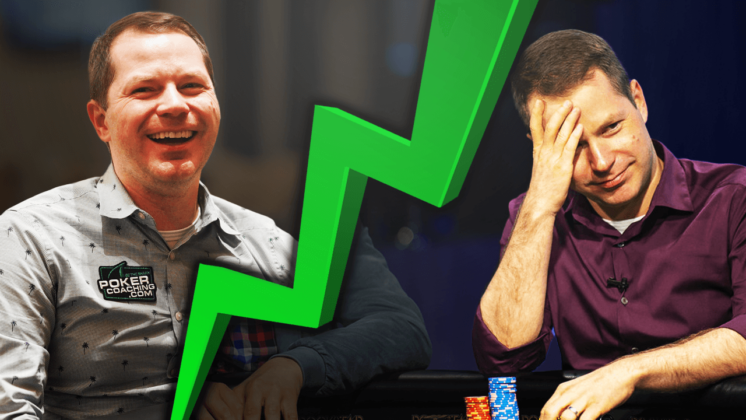No matter how good you are at poker or how much you study, luck will always be a factor at the poker table. How many times have you played a hand perfectly, only to get runner-runner’d and lose your entire stack? Poker can be an “unfair” game at times, with the negative side of variance being a common cause for poker players to give up the game entirely. However, what if I told you there was something you could do to alleviate the impacts of variance? Better yet, what if the key to countering variance was, in essence, simply to play more poker? Playing more poker while also reducing your risk of ruin, sounds like a pretty good deal huh?
In this article, I will share how getting in volume and playing a high quantity of hands live or online can help you counter the negative effects of variance. You can’t win every poker hand you play, but playing enough poker hands can help you avoid taking massive hits to your bankroll.
Your Poker Goals, Volume and Variance
It is important for poker players to have a firm understanding of what their goals are when it comes to the game. Poker goals can be incredibly unique and varied depending on the specific player. The good news is: if you play poker simply because you enjoy it and want to have fun, it is very easy for you to accomplish your poker goals! If poker serves as a casual hobby for you rather than a potential source of income, then kickback, have a couple beers with your buddies, and enjoy the time you spend at the poker table.
While it is perfectly fine to simply play poker for the fun of it, if you are reading this article there is a good chance this does not apply to you. Just because someone takes poker seriously, it doesn’t mean they don’t have fun while they play, however, poker is certainly more fun when it is profitable!
If your goals as a poker player entail improving at the game, making as much money as possible from it, and potentially becoming a full-time professional poker player, then you must be prepared for the time commitment that entails. Variance is one of the hardest things to overcome when looking to be a profitable poker player. Countering variance requires you to play enough hands to limit the negative impacts variance can have on your bankroll. If you are not ready or in a position to achieve the volume necessary, it is important you reassess what you look to accomplish as a poker player.
Time Commitment: More Than Just Playing Poker
Before we even cover the amount of volume a profitable poker player must get in at the tables, it is important to recognize how much time you must invest in studying to become/remain a winning player. One of the keys to success at the poker table is to study more than the players you play against. The beautiful thing about this concept is that it does not require talent or high IQ, it simply requires hard work!
If you regularly play in a soft $1/$2 game and know for a fact your fishy opponents are not studying, if you study one or two hours a week you give yourself quite the edge. However, let’s say your regular game is populated by a handful of proficient players that are premium members of PokerCoaching.com. One to two hours a week probably isn’t going to produce the results you like, which means an hour of study a day is likely what you need to win. In the case where you crush $1/$2 and move up to $2/$5, recognize each time you move up the competition will likely get even tougher. The higher the stakes and the tougher the players, the more time you must allot to studying the games you play.
The Math Problem of Volume and Variance in Poker
Alright, you subscribed to PokerCoaching.com, you watched every class and took every quiz, and you are a poker study junkie who cannot get enough of solvers and preflop charts. You have put the work in, now it is time to play!
When working out how much volume you need to play to accomplish your “poker goals”, the question of “how many hours do I need to play?” can be solved with some simple math.
Let’s say you are starting at the lowest stakes with a tiny, $100 bankroll. Playing a simple, fundamental strategy at the microstakes, you win on average $1 per hour. From here, you start allocating a little bit of time to study, and now you make $2 per hour on average. After 100 hours of sticking to this plan, you will have successfully made $200 playing poker.
If you stick to this principle and continue to slowly grow your bankroll, eventually you can move up stakes and in turn increase your hourly rate. If you move up to double your usual stakes and retain the same hourly win-rate, you essentially double the amount of money you make per hour playing poker.
In the modern poker landscape, the jump from small stakes to medium stakes is not a substantial one when it comes to the talent of player pools. By sticking to this sound, mathematical strategy and remaining patient, if you play enough hours it is not out of the realm of possibility for you to make $100,000 a year playing poker!
Understanding The Number Of Hours You Need To Play Poker To Accomplish Your Goals
So far, everything that has been outlined in this article may make the prospect of making good money from playing poker sound incredibly easy and straightforward. Study enough, play a lot, and print. Easy as that right?
While studying a lot and playing a lot can lead to success, we have yet to cover what playing poker “a lot” looks like. That $100,000 a year total highlighted in the above section assumes that on average you are playing 40 hours a week at the appropriate stakes. While achievable, 40 hours a week is a substantial amount of time! Most people spend 40 hours a week working their full-time job, if you spend 8 hours a day working a nine-to-five, finding another eight hours to not just play poker but study the game may be nearly impossible!
Not everyone has the luxury of being able to play and study poker whenever they want, they have a job, family duties, and responsibilities that may hinder them from fully committing. Highlighting the time commitment success at poker takes is not done to discourage readers. The goal of this article is to share what is required to achieve the volume necessary to offset the variance of poker. You may not be able to allocate 40 hours a week to poker, but what if you can allocate 20 hours? You may not make $100,000, but $50,000 is certainly nothing to sneeze at!

Read one of the highest regarded articles on the PokerCoaching.com blog: The Bankroll Bible
Find A Poker Game You Can Beat, Then Get In The Volume
Often you will hear that the key to making money playing poker is finding a game you can beat and playing it as much as you can. You will also often hear “I love playing poker tournaments, that’s why I play them!”. If you play poker for the fun of it and happen to have the most fun playing tournaments, by all means play tournaments! However, it is important to ponder whether or not poker tournaments provide you with the best chance for substantial profit compared to other types of poker. When considering variance and getting the appropriate volume of hands in to offset it, tournaments serve as the hardest variation of poker to reach such volume.
The Problem With Poker Tournaments, Volume, and Variance
You may be a decent poker player when it comes to low stakes poker tournaments. If you cash 20-25% percent of the $60-$200 buy-in poker tournaments you play, it is likely you are a good, low stakes tournament player. Although, even if you have proven yourself in low stakes poker tournaments, playing such tournaments exclusively may be hurting your bottom line, due to variance and other factors.
Rake and Fees
“The rake is the unrecognized killer of almost all small stakes poker players and their bankrolls. It’s difficult to beat 10% rake capped at 3 big blinds in cash games and a 20% rake in tournaments. If you can beat the large rake, it is often for only a small amount. This is why I suggest starting off playing in games with a significantly beatable rake, with a proper bankroll together.”
– Jonathan Little
Poker players love complaining, and their favorite thing to complain about above all other things is the rake. Casinos and poker rooms have to make money, which is why they must pocket a percentage of each pot and buy-in they facilitate. Regardless of the stakes, every poker tournament is going to have some form of rake, but the rake is always felt the most at the low stakes.
Let’s take a look at two tournaments currently scheduled to take place in Las Vegas. One is a $100 buy-in (low stakes) tournament at The Orleans and another is a $400 buy-in (mid-stakes) series tournament at The Venetian.

Image courtesy of PokerAtlas
The $100 buy-in Orleans tournament deducts $24 from each buy-in for the rake and fees, while the $400 Venetian tournament deducts $70. Percentage-wise, the Orleans is deducting 24% of each buy-in while The Venetian is deducting roughly 17% of each buy-in.
Do you see the problem here?
Not only are you essentially being charged more to play in the lower-stakes tournament, but the lower-stakes tournament is also far less profitable than the mid-stakes tournament. You may say “but I can afford to play a $100 tournament, but cannot afford to play the $400 tournament.” If that’s the case, simply not playing either tournament may be in your best interest.
If the poker tournaments you can afford to play are not only less profitable but also come with the highest rate of variance, it may not make sense to have them as your primary focus.
Volume and Poker Tournaments
Even though it is incredibly hard when you are first starting out, good poker players who are willing to put in the time to study can make money by playing poker tournaments. The key to success as a poker tournament player is not just studying, but also understanding the total volume you need to see results.
Variance is a factor within all forms of poker, but it is the most prevalent within poker tournaments. Tournaments come with dramatic swings when it comes to results and impacts on a poker player’s poker tournament bankroll. Even if you are a solid, well-studied poker tournament player, you can still experience 15-20 tournament downswings where you do not cash once. How do you offset this? Getting in enough volume to counter the variance.
If you have the flexibility to play long sessions and live in an area where you have access to profitable tournaments, you may be able to make a good profit playing poker tournaments. While you may be willing to put in the volume, if your bankroll is not deep enough to withstand a prominent, tournament downswing, you may not be in a position to grind tournaments effectively. If this applies to you, it is recommended you look elsewhere for easier, more consistent poker income.
Low Stakes Cash Games: The Easiest Way To Make Money Playing Poker
In the current poker landscape, the easiest way to make money playing poker is by playing low stakes, live cash games. If $1/$2 or $1/$3 no-limit hold’em cash games are offered at your local poker room or casino, they are by far the best opportunity for poker players wanting to grind and make a profit.
A major contributing factor to why low stakes cash games offer the best opportunity for poker players to make money is that they are simply easier. If you are studying to be a solid poker tournament player, there are a multitude of variables such as stack size, tournament stages, and payout implications that must be considered within the context of each hand. However, if you are a cash game grinder you really only have to study how to play one or two different stack sizes. Cash games offer frequent, familiar spots for you to regularly play and execute profitably. Simply put, while you must still study frequently to beat cash games, they require less study at lower stakes compared to poker tournaments.
You will not secure massive scores in cash games like you would in poker tournaments, but the consistent, steady revenue they can provide offers poker players who are just starting out an easier path to building their bankroll. If you put in the time and become a consistent cash game winner, you can potentially use some of your cash game bankroll to play the occasional tournament or transition entirely when you are ready.
“Whether you compete at the micro stakes or are a high stakes crusher, cash games offer poker players a great way to increase their bankroll whether playing poker online or in a poker room.”
– Jonathan Little
Online Cash Games
Online cash games offer incredibly low stakes (like $0.01/$0.02) for cash game grinders to cut their teeth while remaining in the comfort of their own home. While the stakes are lower and the games are more convenient, it comes as a surprise to many recreational poker players when they hear that online cash games, even the ones that are lower than $1/$2, are usually tougher than live $1/$2 and $1/$3 games.
Why are online cash games usually hard than live cash games? Well, the ability to remove external distractions is much easier when playing from home. No live tells, no access to cocktail service, and if you get nervous at the poker table, you probably perform much better in front of the computer.
Multi-Tabling To Achieve Volume
One of the biggest benefits of playing poker online is being able to multi-table. If you are card dead in a live cash game, you may feel like you are wasting your time as your hourly-rate-average slowly decreases. However, if you are able to play 6-12 tables at once, it is incredibly unlikely you will be card dead as you are seeing way too many hands to never glimpse a good one.
Multi-tabling makes achieving the proper volume to negate variance much easier for poker players who do not play full-time. While it is easier for some and harder for others, if you are able to simply add just one or two additional tables you are already seeing 2-3 times the number of hands you normally would. Multi-tabling may be hard for you at the start, but with experience, you can slowly add additional tables and achieve the volume you need to succeed.
Conclusion
Looking back to the beginning of this article, success in poker is dependent on the poker player. If your goal is to make a substantial income playing the game you love, you must be prepared to put in the time necessary to not just play but study the game. We call them grinders for a reason, as success in poker requires a substantial time investment at and away from the table. Not everyone is in a situation where they can achieve the volume to offset variance, but if you are willing and able, you can drastically improve your income by putting the work in.




Pingback: Poker Downswings – How to Avoid Costly Mistakes